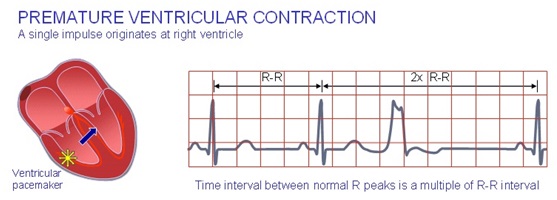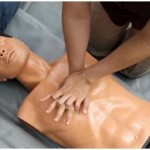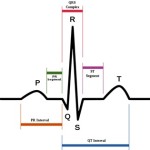What are premature ventricular contractions (PVCs)? They are a common cause of irregular heart rhythms. A heartbeat is created by an electrical signal that originated in an area of specialized cells in the heart’s upper right chamber, the right atrium. This electrical signal travels down through the heart to the atrioventricular (AV) node, a cluster of specialized cells in the center of the heart. The signal passes from the AV node to the special fibers embedded in the heart walls to the ventricles (the lower chambers of the heart). When the electrical current arrives in the ventricles, force them to contract and pump oxygen-rich blood out to the body.
What could cause or what is a premature ventricular contraction is what is explained in this text. A premature ventricular contraction (PVC) is a too-early heartbeat that originates in the ventricles and disrupts the heart’s normal rhythm. The premature ventricular contraction first starts with a normal beat, an extra beat or let say the PVC, a slight pause and then a little stronger beat than the normal beat. During the pause that is following the PVC the heart fills with more blood and that gives the next beat more force. This pattern may occur randomly or at definite intervals.
Symptoms of premature ventricular contractions (PVCs)
 If the PVC occurs as a single premature beat, in this case most of the patients may describe the feeling as a palpitation or skipped beat. The beat that follows after the PVC is going to be strong enough and the patient can feel pain and discomfort in the chest. Some individuals that have frequent PVCs or a series of them may experience a fluttering sensation in the chest or neck. This frequent PVCs may also reduce the heart’s pumping ability and the individual may also experience weakness, dizziness or fainting.
If the PVC occurs as a single premature beat, in this case most of the patients may describe the feeling as a palpitation or skipped beat. The beat that follows after the PVC is going to be strong enough and the patient can feel pain and discomfort in the chest. Some individuals that have frequent PVCs or a series of them may experience a fluttering sensation in the chest or neck. This frequent PVCs may also reduce the heart’s pumping ability and the individual may also experience weakness, dizziness or fainting.
Risk groups?
PVCs occur more commonly in older people, but almost everyone has PVCs at some time. We have had PVCs from childhood through adulthood. The most targeted people for PVCs are those individuals with underlying heart disease, including a history of heart attack or with a family history of cardiac arrhythmias.
How premature ventricular contractions can be diagnosed?
Premature ventricular contraction can be difficult to diagnose because they occur at very unpredictable intervals. Sometimes premature ventricular contractions are very difficult for the physicians to detect during a routine physical unless the patient has an exam for the other structural heart problems and it shows that the patient has PVCs. Most of the patients can discover that they have PVCs during a routine echocardiogram (ECG). If the patient has other heart problems than the premature ventricular contractions can be discovered during the other diagnostic testing for that condition.
If a patient has symptoms of premature ventricular contractions he/she needs to consult with a doctor or a heart specialist. The consultation will undergo an ECG, the standard test for diagnosing PVCs. This is a standard test that is inexpensive, non-invasive and accurate. With the portable ECG you will have 24-48 hours continuous recording for those patients who experience PVCs at least once a day which is not frequent at all. The information from a Holter monitor is very useful in determines the frequency of PVCs and correlating symptoms such as faintness or dizziness with the arrhythmia.
Risks associated with premature ventricular contractions
The premature ventricular contractions occur infrequently and are benign. The premature ventricular contractions may increase the risk of developing other, more serious cardiac arrhythmias. Some patients that have underlying heart disease, structural abnormalities in the heart or have had a previous heart attack have a higher risk of death.
What is the treatment for PVCs?
Patients with occasional PVCs and with no other symptoms and no underlying heart disease or structural problems, there is no treatment necessary. You can simply control your PVCs by reducing or eliminating your caffeine, tobacco and alcohol intake. Less stress and anxiety is strongly recommended. If you want to change your medications for any reason you should talk with your doctor or physician first.
A beta blocker may be prescribed for those patients with PVCs who have heart failure or who have had a heart attack. The beta blockers are safe and effective drugs that are often used to treat heart arrhythmias. For frequent PVCs the calcium channel blockers may be prescribed to fix the potent heart rhythm.
Ablation is another treatment option for some other patients that have more frequent or prolonged premature ventricular contractions. This therapy provides radiofrequency waves to vaporize tiny amounts of tissue in the area of the heart where the extra beat originates. The ablation therapy is like a replacement therapy for those patients that cannot tolerate the beta blockers. The interventional cardiologists are experts in radiofrequency ablation and they usually can prescribe the replacement therapy.






















